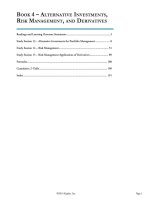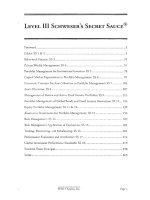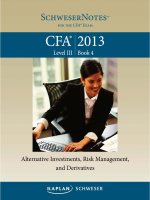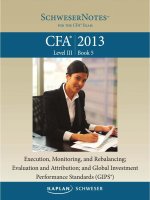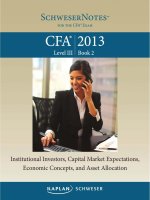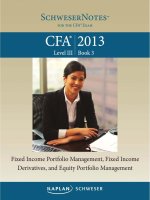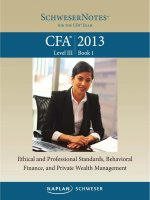2019 CFA level 3 qbank reading 30 alternative investments portfolio management answers
Bạn đang xem bản rút gọn của tài liệu. Xem và tải ngay bản đầy đủ của tài liệu tại đây (1.08 MB, 47 trang )
10/12/2018
Learning Management System
Question #1 of 87
Compared to stocks, direct equity investments in real estate have had:
A) higher volatility of returns.
B) lower volatility of returns.
C) about the same volatility of returns.
Explanation
.in
Lower volatility is the correct answer. The average return has actually been lower than those
of stocks over the long-term.
en
tre
(Study Session 15, Module 30.2, LOS 30.g)
Related Material
Question #2 of 87
bo
ok
c
SchweserNotes - Book 4
m
Which of the following most likely represents the timeline of a private equity fund?
A) The commitment period of 2 years, the life of the fund reaching 5 years, an option
.o
to extend the fund 3 more years.
w
w
B) The commitment period of 7-10 years, the life of the fund reaching 12-15 years, an
option to extend the fund 5 more years.
w
C) The commitment period of 5 years, the life of the fund reaching 7-10 years, an
option to extend the fund 5 more years.
Explanation
The commitment period usually occurs during the rst ve years when the sponsor gives the
capital calls. The expected life of these funds is 7-10 years, and there is often an option to
extend the life up to 5 more years.
(Study Session 15, Module 30.3, LOS 30.k)
Related Material
SchweserNotes - Book 4
/>
1/47
10/12/2018
Learning Management System
Question #3 of 87
With respect to managed futures and real estate, legal issues and valuation methods are
special due diligence issues associated with:
A) real estate only.
B) managed futures only.
C) real estate and managed futures.
Explanation
Related Material
Question #4 of 87
bo
ok
c
SchweserNotes - Book 4
en
tre
(Study Session 15, Module 30.1, LOS 30.d)
.in
Active, direct investment in real estate requires all the due diligence checkpoints. For the
investment process due diligence checkpoint, valuation methods deserve special attention.
Under documents, there may be special zoning and legal issues.
m
In alternative investments, distressed debt arbitrage seeks to earn a return from:
A) an improvement in the prospects of the rm only.
w
w
rm.
.o
B) either the decline of the stock to zero or an improvement in the prospects of the
C) the decline of the stock to zero only.
w
Explanation
Distressed debt arbitrage is the purchasing of a company's distressed debt while selling the
equities short. The investment can earn a return in two ways: 1) if the equity declines or goes
to zero the investor gains from the short position but may continue to gain from the long
bond position, 2) if the company's prospects improve, because of the seniority of bond
claims, the returns to bond holders should be greater than that of equity holders. The
possibility of returns from two events provides a good market opportunity.
(Study Session 15, Module 30.6, LOS 30.t)
Related Material
SchweserNotes - Book 4
/>
2/47
10/12/2018
Learning Management System
Question #5 of 87
In the due diligence process of selecting an active manager of alternative investments,
"assessing the organization of the manager's rm" means assessing the:
A) terms and structure of the investments the manager o ers.
B) stability of the rm and sta turnover.
C) documents (e.g., prospectuses of the investments the manager o ers).
Explanation
.in
Assessing the organization of the manager and his/her operations means assessing whether
it is stable and well run. This would also mean measuring the sta turnover.
(Study Session 15, Module 30.1, LOS 30.b)
en
tre
Related Material
Question #6 of 87
bo
ok
c
SchweserNotes - Book 4
In the due diligence process of selecting an active manager of alternative investments,
m
"assessing the investment process" means assessing the:
.o
A) stability of the organization and employee turnover.
w
w
B) special assets the manager o ers.
C) competitive edge the manager o ers.
w
Explanation
In the due diligence checkpoints, "assessing the investment process" means assessing the
competitive edge the manager o ers. The special assets are associated with the "market
opportunity" checkpoint. The stability of the organization and employee turnover is
associated with the "organization" checkpoint.
(Study Session 15, Module 30.1, LOS 30.b)
Related Material
SchweserNotes - Book 4
Question #7 of 87
/>
3/47
10/12/2018
Learning Management System
Which of the following statements regarding how managed futures are typically structured is
least accurate?
A) Commodity trading advisors are responsible for actively buying and selling futures
contracts.
B) Commodity trading advisors hire commodity pool operators to manage the pool of
futures contracts.
C) Commodity pool operators can act as commodity trading advisors who actively
manage a pool of futures contracts.
Explanation
Related Material
SchweserNotes - Book 4
.o
m
Question #8 of 87
bo
ok
c
(Study Session 15, Module 30.5, LOS 30.s)
en
tre
.in
Managed futures programs are typically run by Commodity Pool Operators (CPOs). CPOs can
themselves be commodity trading advisors (CTAs) or will hire CTAs to actually manage all or
part of the pool. In the United States, both must be registered with the U.S. Commodity
Futures Trading Commission and the National Futures Association. Some CTAs may choose to
work independently outside of a public or private CPO structure.
Compared to common stockholders, investors who use convertible preferred stock to make
w
w
venture capital investments will receive the promised dividend:
A) only if common stockholders receive a dividend or a disbursement through
w
liquidation.
B) before common stockholders receive a dividend or a disbursement through
liquidation.
C) before common stockholders receive a dividend but not if there is a liquidation.
Explanation
Preferred stockholders must be paid a speci ed amount, say twice the initial investment,
before common stockholders can receive cash in the form of dividends or distributions
through liquidation.
(Study Session 15, Module 30.3, LOS 30.j)
Related Material
/>
4/47
10/12/2018
Learning Management System
SchweserNotes - Book 4
Question #9 of 87
In distressed securities investing, a private equity fund that seeks to partner with the company
in which the fund invests would most likely be called:
A) an orphan equity fund.
B) a high yield fund.
.in
C) a vulture fund.
en
tre
Explanation
bo
ok
c
A "vulture fund" is a private equity fund that uses an "active" approach where the fund or
investor acquires positions in the company, and the investment gives some measure of
control. The investor can then in uence and assist the company and then acquire more
ownership in the process of any reorganization. By providing services and obtaining a
strategic position, the investors create their own opportunity.
(Study Session 15, Module 30.6, LOS 30.t)
Related Material
.o
m
SchweserNotes - Book 4
w
w
Question #10 of 87
w
With respect to weighting schemes for hedge fund indices, the weighting schemes:
A) are always based upon assets under management.
B) can be either equally weighted or based upon assets under management.
C) are always equally weighted.
Explanation
Weighting schemes are usually either equally weighted or based upon assets under
management.
(Study Session 15, Module 30.4, LOS 30.e)
Related Material
SchweserNotes - Book 4
/>
5/47
10/12/2018
Learning Management System
Question #11 of 87
In making investments in private equity, diversi cation is:
A) possible by holding a number of positions, but usually only for investors with
portfolios over $100 million.
B) possible by holding a number of positions, and the size of the portfolio is not an
issue.
C) not possible to any investor.
.in
Explanation
Related Material
SchweserNotes - Book 4
m
Question #12 of 87
bo
ok
c
(Study Session 15, Module 30.3, LOS 30.l)
en
tre
Diversi cation through number of positions can be a problem since commitments are usually
large. Usually investors with portfolios well over $100 million can invest in the necessary 5-10
investments needed for diversi cation.
.o
A hedge fund that takes positions in convertible bonds or convertible preferred stock and then
w
w
takes other positions in the underlying stock would be most accurately placed in the style
category:
w
A) distressed securities.
B) equity market neutral.
C) convertible arbitrage.
Explanation
Convertible arbitrage usually takes positions in convertible bonds or preferred stock as well
as warrants, etc..., and then takes other positions in the underlying stock.
(Study Session 15, Module 30.4, LOS 30.o)
Related Material
SchweserNotes - Book 4
/>
6/47
10/12/2018
Learning Management System
Question #13 of 87
Special due diligence issues such as valuation, credit analysis, and nancial structure are most
likely associated with investments:
A) in distressed securities.
B) made indirectly in real estate.
C) in managed futures.
.in
Explanation
en
tre
Distressed securities investing requires due diligence with respect to business valuation,
credit analysis, and assessing the company's problems and nancial structure.
Related Material
Question #14 of 87
bo
ok
c
SchweserNotes - Book 4
In distressed securities investing, the fact that there can be cyclical supply and demand for
w
w
B) J-factor risk.
.o
A) market liquidity risk.
m
these investments is associated with:
C) arbitrage risk.
w
Explanation
Market liquidity risk refers to the low liquidity and the fact that there can be cyclical supply
and demand for these investments.
(Study Session 15, Module 30.6, LOS 30.u)
Related Material
SchweserNotes - Book 4
Question #15 of 87
/>
7/47
10/12/2018
Learning Management System
Hedge fund managers with good track records:
A) generally continue to have good track records.
B) often demand higher incentive fees.
C) usually lower their fees to increase the assets under management.
Explanation
Managers with good track records often demand higher incentive fees. The concern for
investors is whether the manager with a good historical record can continue to perform well
enough to justify the higher fees.
(Study Session 15, Module 30.3, LOS 30.k)
.in
Related Material
en
tre
SchweserNotes - Book 4
bo
ok
c
Question #16 of 87
A hedge fund that focuses on earning returns from mergers, spin-o s, and takeovers would be
most accurately placed in which style category?
C) Hedged equity.
w
w
Explanation
.o
B) Merger arbitrage.
m
A) Equity market neutral.
w
Merger arbitrage focuses on returns from mergers, spin-o s, takeovers, etc... For example, if
company X announces it will acquire company Y, the manager might buy shares in Y and
short X.
(Study Session 15, Module 30.4, LOS 30.o)
Related Material
SchweserNotes - Book 4
Question #17 of 87
In the structure of a hedge fund, which of the following is least accurate concerning a lock-up
period? A lock-up period:
/>
8/47
10/12/2018
Learning Management System
A) establishes a cap on new investment.
B) establishes exit windows.
C) establishes a minimum investment period for each investment.
Explanation
A lock-up period is a common provision in hedge funds. Lock-up periods limit withdrawals by
requiring a minimum investment period, e.g., 1-3 years, and designating exit windows. The
rationale is to prevent sudden withdrawals that could force the manager to have to unwind
positions.
(Study Session 15, Module 30.4, LOS 30.p)
Related Material
en
tre
.in
SchweserNotes - Book 4
Question #18 of 87
bo
ok
c
With respect to the role of alternative assets in a portfolio, it can be best described as exposure
to:
A) unique asset classes and/or special investment strategies.
m
B) special investment strategies.
Explanation
.o
C) unique asset classes only.
w
w
We can categorize alternative investments into three categories corresponding to the role
they play in the portfolio.
w
1. Exposure to asset classes that stocks and bonds cannot provide.
2. Exposure to special investment strategies such as those used by hedge funds.
3. Investments that use both special strategies and unique asset classes (e.g., funds that
invest in private equity and distressed securities).
(Study Session 15, Module 30.1, LOS 30.a)
Related Material
SchweserNotes - Book 4
Question #19 of 87
/>
9/47
10/12/2018
Learning Management System
Direct investment in commodities has become easier for all investors because of the:
A) increased number of hedge funds in these markets.
B) increase in hedging activities of managers in rms that produce and/or deal in
commodities.
C) the increase in the number of commodity indices.
Explanation
There has been an increase in the number of indices making it easier for smaller investors to
invest in commodities and take derivative positions in commodities.
.in
(Study Session 15, Module 30.5, LOS 30.m)
Related Material
bo
ok
c
Question #20 of 87
en
tre
SchweserNotes - Book 4
Which stage of nancing generally supports further expansion of production and sales?
A) The second stage.
m
B) The third stage.
w
w
Explanation
.o
C) The rst stage.
w
The second stage of nancing supports further expansion of production and sales. The third
stage of nancing typically can support additional major expansion. First stage funding is
used to begin manufacturing and sales.
(Study Session 15, Module 30.3, LOS 30.h)
Related Material
SchweserNotes - Book 4
Question #21 of 87
For use in evaluating hedge funds, which of the following is NOT a shortcoming of the Sharpe
ratio?
/>
10/47
10/12/2018
Learning Management System
A) It uses an arbitrary reference return.
B) It is a stand-alone measure that ignores the diversi cation contributions of a hedge
fund to an overall portfolio.
C) It has had little success in predicting winners.
Explanation
The Sharpe ratio is a very standardized measure, and none of the inputs are arbitrary. Both
remaining choices are recognized shortcomings of the Sharpe ratio.
(Study Session 15, Module 30.4, LOS 30.f)
Related Material
en
tre
.in
SchweserNotes - Book 4
Question #22 of 87
bo
ok
c
Compared to indirect investments in commodities, direct investments o er:
A) less exposure to commodity returns but lower carrying costs.
B) more exposure to commodity returns but higher carrying costs.
m
C) less exposure to commodity returns and higher carrying costs.
Explanation
w
w
.o
Often indirect investments via investing in a company producing the commodity provide
lower exposure because the managers hedge the very exposure the investor seeks. Direct
investments in commodities incur costs of storage called carrying costs.
(Study Session 15, Module 30.5, LOS 30.m)
w
Related Material
SchweserNotes - Book 4
Question #23 of 87
Frank Campbell, CFA, has a client who wants to make a venture capital investment. Campbell is
considering recommending convertible preferred. Which of the following is most likely an
advantage of using convertible preferred stock in making an investment in venture capital?
Convertible preferred stock:
/>
11/47
10/12/2018
Learning Management System
A) bene ts in the event of a company buyout.
B) has dividends that can increase.
C) ranks ahead of debt investors.
Explanation
Convertible preferred stock has a conversion feature that can be exercised if the stock is
purchased at a premium as in a buyout. Debt ranks ahead of preferred stock and preferred
dividends are normally xed.
(Study Session 15, Module 30.3, LOS 30.j)
Related Material
en
tre
.in
SchweserNotes - Book 4
Question #24 of 87
bo
ok
c
With respect to information e ciency and potential for diversi cation, in comparing alternative
investments to exchange traded stocks, the markets for alternative investments are:
A) more informationally e cient and provide more opportunity for diversi cation.
B) less informationally e cient and provide less opportunity for diversi cation.
.o
Explanation
m
C) less informationally e cient and provide more opportunity for diversi cation.
w
w
Alternative investments can provide exposure to unique risks and trading strategies and thus
provide good diversi cation to a stock and bond portfolio. The markets for alternative
investments are informationally less e cient than most stock markets.
w
(Study Session 15, Module 30.1, LOS 30.a)
Related Material
SchweserNotes - Book 4
Question #25 of 87
/>
12/47
10/12/2018
Learning Management System
William Jones, CFA, has a client who wants to invest in a hedge fund that has the strategy of
investing in equities and has among its goals the elimination of systematic risk. Jones has found
two funds that he thinks are well run: the Marius Fund that uses an equity market neutral
strategy and the Hera Fund that uses a hedged equity strategy. Given the client's stated
preferences, Jones should recommend:
A) the Hera Fund only.
B) either fund.
C) the Marius Fund only.
Explanation
bo
ok
c
(Study Session 15, Module 30.4, LOS 30.o)
en
tre
.in
Equity market neutral is usually the attempt to exploit price discrepancies through long and
short positions. This strategy also has the goal of the systematic risks canceling because of
the long and short positions. Hedged equity strategies take long and short positions in under
and overvalued securities, respectively, like equity market neutral strategies. The di erence is
that hedged equity strategies do not focus on balancing the positions to eliminate systematic
risks.
Related Material
m
SchweserNotes - Book 4
.o
Question #26 of 87
w
w
With respect to the terms "formative-stage companies" and "expansion-stage companies",
which are considered issuers of venture capital?
w
A) Formative-stage companies only.
B) Both formative-stage companies and expansion-stage companies.
C) Neither formative-stage companies nor expansion-stage companies.
Explanation
Issuers of venture capital include formative-stage companies that are either new or young
and expansion-stage companies that need funds to expand their revenues or prepare for an
IPO.
(Study Session 15, Module 30.3, LOS 30.h)
Related Material
SchweserNotes - Book 4
/>
13/47
10/12/2018
Learning Management System
Question #27 of 87
In the life of a private equity fund, capital calls represent the:
A) request for more capital by the fund sponsor from the investors after the
commitment period.
B) request for more capital by the fund sponsor from the investors during the
commitment period.
C) request for more capital by the fund sponsor from the investors at the beginning of
.in
the fund prior to the commitment period.
en
tre
Explanation
The timeline includes the sponsor getting commitments from the investors at the start of the
fund and then giving "capital calls" over the rst ve years (typically) called the commitment
period to bring in the promised cash.
bo
ok
c
(Study Session 15, Module 30.3, LOS 30.k)
Related Material
m
SchweserNotes - Book 4
.o
Question #28 of 87
w
w
Jill Tillman, CFA, has a client who wishes to invest in private equity. The client's total portfolio is
$2 million. The client wants to invest $250,000 in private equity, wants to keep the money
w
invested for 7-10 years, and does not need liquidity. Tillman should:
A) invest the client’s money because private equity has the desired properties.
B) not invest the money because private equity requires a longer holding period than
speci ed by the client.
C) not invest the money because it represents too much of the client’s portfolio.
Explanation
Private equity has low liquidity. The allocation to this class should be 5% or less with a plan to
keep the money invested for 7-10 years. Since the client only has $2 million, the $250,000
(12.5%) requested investment is too large.
(Study Session 15, Module 30.3, LOS 30.l)
/>
14/47
10/12/2018
Learning Management System
Related Material
SchweserNotes - Book 4
Question #29 of 87
Bernice Clark, CFA, is analyzing the portfolio of a private wealth client. In the process, Clark
wants to address special issues that alternative investments raise for her client. The special
issues would:
.in
A) not include measuring the ownership in the client’s corporate bond portfolio and
not include measuring the client’s ownership in closely held companies.
en
tre
B) not include measuring the ownership in the client’s corporate bond portfolio but
would include measuring the client’s ownership in closely held companies.
C) include measuring the ownership in the client’s corporate bond portfolio and the
bo
ok
c
client’s ownership in closely held companies.
Explanation
m
Special issues that advisors for private-wealth clients should address are tax issues,
determining suitability, communicating with the client, decision risk, and determining if they
have a large position in a closely-held company. Measuring the ownership in corporate bonds
is not a "special issue."
Related Material
.o
(Study Session 15, Module 30.1, LOS 30.c)
w
w
w
SchweserNotes - Book 4
Question #30 of 87
Diversi cation is one of the major issues that must be addressed when formulating a private
equity investment strategy. To be considered diversi ed, investors must be able to invest in 5
to 10 di erent investments. Which of the following statements regarding private equity is most
accurate?
A) Liquidity is usually not an issue with private equity due to its positive correlation
with equities.
/>
15/47
10/12/2018
Learning Management System
B) Smaller portfolios can achieve the necessary diversi cation by investing in private
equity funds.
C) The typical private equity investment is usually less than 7 years.
Explanation
Private equity is considered illiquid with the typical commitment being 7 to 10 years. Large
portfolios of at least $500 million are needed to invest in 5 to 10 di erent investments
achieving the necessary diversi cation. Smaller portfolios can invest in private equity funds
achieving the necessary diversi cation.
(Study Session 15, Module 30.3, LOS 30.l)
Related Material
en
tre
.in
SchweserNotes - Book 4
Question #31 of 87
bo
ok
c
In contrast to venture capital funds, buyout funds usually have:
A) less frequent losses and less upside potential.
B) less frequent losses and more upside potential.
m
C) more frequent losses and more upside potential.
.o
Explanation
w
w
These di erences are the natural consequence of the buyout funds purchasing entities in
later stages of development or even established companies where the risks are lower.
(Study Session 15, Module 30.3, LOS 30.i)
w
Related Material
SchweserNotes - Book 4
Question #32 of 87
As an investment, the commodity energy is:
A) nonstorable and a hedge against in ation.
B) storable and a hedge against in ation.
C) nonstorable but not a hedge against in ation.
/>
16/47
10/12/2018
Learning Management System
Explanation
Commodities that are not agricultural products tend to be storable and hedges against
in ation. Energy is both storable and its return has been correlated with in ation.
(Study Session 15, Module 30.5, LOS 30.n)
Related Material
SchweserNotes - Book 4
.in
Question #33 of 87
expect distressed securities to contribute:
A) diversi cation but not enhanced return.
B) enhanced return but not diversi cation.
bo
ok
c
C) both enhanced return and diversi cation.
en
tre
When added to a portfolio of stocks and bonds, based upon historical performance, we can
Explanation
m
Distressed securities have provided a relatively high average return but large negative skew
so comparisons using averages and Sharpe ratios or average return-to-volatility ratios can be
misleading. The returns are often event-driven so the return is uncorrelated to the overall
stock market and can provide diversi cation.
w
w
Related Material
.o
(Study Session 15, Module 30.6, LOS 30.f)
w
SchweserNotes - Book 4
Question #34 of 87
With respect to adding managed futures investing to a stock and bond portfolio:
A) a trend-following strategy will o er lower diversi cation than a contrarian strategy.
B) a trend-following strategy will o er more diversi cation than a contrarian strategy.
C) a trend-following strategy will o er diversi cation equal to that of a contrarian
strategy.
Explanation
/>
17/47
10/12/2018
Learning Management System
For managed futures funds, a trend-following strategy will o er lower diversi cation than a
contrarian strategy. This should be obvious since the trends would be those of the cash
markets for which the investor is trying to obtain diversi cation. The market for the
underlying securities will also play a role.
(Study Session 15, Module 30.1, LOS 30.d)
Related Material
SchweserNotes - Book 4
.in
Question #35 of 87
Commodities can be categorized into storable and nonstorable. Which category, if any, should
A) Both storable and nonstorable commodities.
C) Nonstorable commodities.
Explanation
bo
ok
c
B) Storable commodities.
en
tre
an analyst recommend as a hedge against in ation?
m
Storable commodities like energy and metals have returns that are positively correlated with
in ation. The positive correlation means the real return will tend to remain positive even
when in ation increases.
Related Material
.o
(Study Session 15, Module 30.5, LOS 30.n)
w
w
w
SchweserNotes - Book 4
Question #36 of 87
In contrast to venture capital funds, buyout funds usually have a:
A) higher level of leverage and earlier and steadier cash ows.
B) lower level of leverage and earlier and steadier cash ows.
C) higher level of leverage and later and more erratic cash ows.
Explanation
/>
18/47
10/12/2018
Learning Management System
Buyout funds are usually investing in later-stage companies where the risks are lower. The
cash ows are steadier and the investors can use more leverage.
(Study Session 15, Module 30.3, LOS 30.i)
Related Material
SchweserNotes - Book 4
Question #37 of 87
In the special issues that alternative investments raise for investment advisors of private wealth
en
tre
A) both are explicitly special issues to consider.
.in
clients, with respect to tax issues and suitability:
B) suitability is a special issue to consider but tax issues are not.
C) tax issues are a special issue to consider but suitability is not.
bo
ok
c
Explanation
Special issues that advisors for private-wealth clients should address are tax issues,
determining suitability, communicating with the client, decision risk, and determining if they
have a large position in a closely-held company.
Related Material
w
w
.o
SchweserNotes - Book 4
m
(Study Session 15, Module 30.1, LOS 30.c)
w
Question #38 of 87
As an asset class, over the period from 1996 to 2015, commodities:
A) enhanced the return of an equally weighted stock and bond portfolio due to
commodities’ low correlation with stocks and bonds.
B) underperformed the return of an equally weighted stock and bond portfolio both
on an absolute and risk adjusted basis.
C) enhanced the risk adjusted return of an equally weighted stock and bond portfolio
due to commodities’ low correlation with stocks and bond.
Explanation
/>
19/47
10/12/2018
Learning Management System
The results show that over the 1996 to 2015 period studied, when commodities were added
to an equally weighted portfolio of stocks and bonds, commodities underperformed U.S.
equity and bond markets both on an absolute and risk adjusted basis. Due to the low
correlation of the returns of the S&P GSCI with the S&P 500 (0.25) and negative correlation
with the Bloomberg Barclays U.S. Government Bond Index (–0.10), we would expect to see
diversi cation bene ts with improving average return-to-volatility ratios but the results do
not support those conclusions. The overall conclusion in the CFA text is that commodities
o er diversi cation bene ts due to their low correlation with stocks and slightly negative
correlation and bonds even though the results of the time period studied suggests otherwise.
(Study Session 15, Module 30.5, LOS 30.f)
Related Material
en
tre
.in
SchweserNotes - Book 4
Question #39 of 87
Which of the following would be among the most common compensation structures for the
bo
ok
c
manager of a hedge fund?
A) An assets-under-management fee of 1.5% and a lock-up fee of 20%.
B) An assets-under-management fee of 1.5% and an incentive fee of 20% of the dollar
return over the initial investment.
m
C) An assets-under-management fee of 20% and an incentive fee of 1.5% of the dollar
w
w
Explanation
.o
return over the initial investment.
w
The most common compensation structure of a hedge fund consists of an assets-undermanagement fee, or AUM fee, of about 1%-2% and an incentive fee of 20% of "pro ts". The
de nition of pro t should be spelled out in the terms of the investment. It could be dollar
return over the initial investment, for example, or the dollar return above the initial
investment increased by some hurdle rate.
(Study Session 15, Module 30.4, LOS 30.p)
Related Material
SchweserNotes - Book 4
Question #40 of 87
/>
20/47
10/12/2018
Learning Management System
The structure, explanation of performance data, and style and strategy are special due
diligence issues most associated with:
A) distressed securities.
B) hedge funds.
C) direct real estate investing.
Explanation
Due diligence in hedge funds should include an inquiry into the following list: the structure of
the hedge fund, the strategy and style of the hedge fund, performance data since inception
with explanations, risk measures, research, administration, and legal issues.
.in
(Study Session 15, Module 30.1, LOS 30.a)
Related Material
bo
ok
c
Question #41 of 87
en
tre
SchweserNotes - Book 4
With respect to due diligence costs and liquidity, in comparing alternative investments to
exchange traded stocks, the markets for alternative investments have:
m
A) more liquidity and higher due diligence costs.
.o
B) less liquidity and lower due diligence costs.
w
w
C) less liquidity and higher due diligence costs.
Explanation
w
The common features are: low liquidity, provide good diversi cation, due diligence costs are
high, di cult appraisals, and the markets for alternative investments are informationally less
e cient than most stock markets.
(Study Session 15, Module 30.1, LOS 30.a)
Related Material
SchweserNotes - Book 4
Question #42 of 87
With respect to the operations of a hedge fund, a high water mark is designed to:
/>
21/47
10/12/2018
Learning Management System
A) prevent a manager from allowing the fund to become so large that it cannot be
managed e ciently and/or use its selected style e ectively.
B) put a cap on the assets-under-management fee.
C) prevent a manager from being paid twice for the same gains of the fund.
Explanation
The high-water mark provision is designed to prevent payment to a manager twice for the
same gains. If a fund goes from $100 to $120 in value and the manager earns an incentive fee
for the $20 gain, and then the fund's value goes down to $110 and back to $120, the manager
will not earn a fee for the gain from $110 back to $120. $120 was a "high water mark."
.in
(Study Session 15, Module 30.4, LOS 30.p)
Related Material
bo
ok
c
Question #43 of 87
en
tre
SchweserNotes - Book 4
If a hedge fund goal is the elimination of systematic risk, a problem for the fund in motivating
the manager is that:
A) the standard incentive fee only applies to assets under management and would not
m
reward the elimination of systematic risk.
.o
B) it is impossible to gauge the degree to which systematic risk has been eliminated.
w
w
C) the standard incentive fee only applies to raw earnings and would not reward the
elimination of systematic risk.
w
Explanation
There is some controversy concerning fees because a manager may have or should have
other goals than simply earning a gross return. For example, the manager may/should be
providing limited downside risk and diversi cation. The basic incentive fee does not reward
this service.
(Study Session 15, Module 30.3, LOS 30.k)
Related Material
SchweserNotes - Book 4
Question #44 of 87
/>
22/47
10/12/2018
Learning Management System
When evaluating the performance of a hedge fund that uses leverage, the convention is to:
A) not attempt to evaluate the fund because the existence of leverage makes such an
assessment impossible.
B) treat an asset as if it were fully paid to e ectively “look through” the leverage.
C) use an optimization model to determine the weights on the book and debt values.
Explanation
The conventions for dealing with leverage is to treat an asset as if it were fully paid to
e ectively "look through" the leverage. When derivatives are included, the same principle of
deleveraging is applied.
.in
(Study Session 15, Module 30.4, LOS 30.r)
Related Material
bo
ok
c
Question #45 of 87
en
tre
SchweserNotes - Book 4
William Jones, CFA, has a client who wants to invest in a hedge fund. Jones might recommend a
fund of funds instead of a single fund for all of the following reasons EXCEPT a fund of funds:
m
A) may serve as a better indicator of aggregate performance of hedge funds.
.o
B) would be more liquid.
w
w
C) would have a lower correlation with equity markets.
Explanation
w
Fund of funds are usually considered good choices for individual investors because they o er
diversi cation, usually o er more liquidity, and su er from less survivorship bias thus they
may serve as a better indicator of aggregate performance of hedge funds. One problem with
fund of funds is that they are usually more correlated with equity markets than an individual
fund, and this lowers their ability to diversify the overall portfolio.
(Study Session 15, Module 30.4, LOS 30.q)
Related Material
SchweserNotes - Book 4
Question #46 of 87
/>
23/47
10/12/2018
Learning Management System
Direct equity real estate investing has the following disadvantages over indirect real estate
investing EXCEPT:
A) less control over the investment’s performance.
B) political risk.
C) high commissions.
Explanation
.in
Direct equity real estate investing has the following disadvantages: lack of divisibility means a
single investment may be a large part of the investor's portfolio. There are high information
cost, high commissions, high operating and maintenance costs, and hands-on management
requirements. There are special geographical risks like neighborhood deterioration and the
political risk of changing tax codes.
en
tre
(Study Session 15, Module 30.2, LOS 30.g)
Related Material
Question #47 of 87
bo
ok
c
SchweserNotes - Book 4
In distressed securities investing, the strategy that focuses on trying to nd opportunities
m
where the prospects will improve is called:
.o
A) long-only value investing. Its returns depend on the fact that not all investors can
w
w
invest in distressed securities.
B) long-only value investing. Its returns depend on the fact that the market for
w
distressed securities is e cient.
C) a momentum strategy. The goal is to nd a rm that has “improvement
momentum.”
Explanation
This is the basic principal of long-only value investing in distressed securities.
(Study Session 15, Module 30.6, LOS 30.t)
Related Material
SchweserNotes - Book 4
/>
24/47
10/12/2018
Learning Management System
Question #48 of 87
The convertibilty feature in convertible preferred stock is important because it means that
preferred stockholders:
A) can block a possible buyout.
B) can convert their claims to equal those of later investors in the company.
C) can bene t from a buyout favorable to common stockholders.
Explanation
.in
Any buyout of the company that is favorable to shareholders will lead to the conversion of
the preferred stock.
(Study Session 15, Module 30.3, LOS 30.j)
en
tre
Related Material
Question #49 of 87
bo
ok
c
SchweserNotes - Book 4
Which of the following commodities is least likely to have returns that are positively correlated
m
with in ation?
w
w
B) Energy.
.o
A) Corn.
C) Industrial metals.
w
Explanation
Nonstorable agricultural commodities returns have returns that are negatively correlated to
in ation. Storable commodities like energy and metals have returns that are positively
correlated with in ation.
(Study Session 15, Module 30.5, LOS 30.n)
Related Material
SchweserNotes - Book 4
Question #50 of 87
/>
25/47
